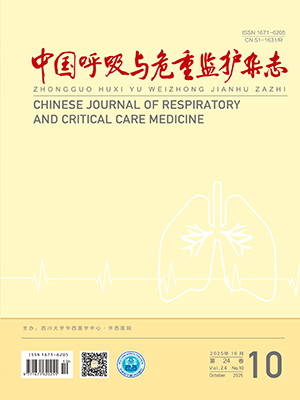| 1. |
Rashid NH, Zaghi S, Scapuccin M, et al. The value of oxygen desaturation index for diagnosing obstructive sleep apnea: a systematic review. Laryngoscope, 2021, 131(2): 440-447.
|
| 2. |
张毅, 刘魏, 靳传林. 羧甲司坦片联合持续气道正压通气治疗老年阻塞性睡眠呼吸暂停低通气综合征患者的临床研究. 中国临床药理学杂志, 2020, 36(11): 1427-1429,1436.
|
| 3. |
Antza C, Kostopoulos G, Mostafa S, et al. The links between sleep duration, obesity and type 2 diabetes mellitus. J Endocrinol, 2021, 252(2): 125-141.
|
| 4. |
Morelli MB, Chavez C, Santulli G. Angiopoietin-like proteins as therapeutic targets for cardiovascular disease: focus on lipid disorders. Expert Opin Ther Targets, 2020, 24(1): 79-88.
|
| 5. |
Wang Y, Jiang HF, Liu BB, et al. Brown adipose tissue activation is involved in atherosclerosis of ApoE-/- mice induced by chronic intermittent hypoxia. Front Cardiovasc Med, 2021, 8: 751519.
|
| 6. |
Eltzschig HK, Eckle T. Ischemia and reperfusion--from mechanism to translation. Nat Med, 2011, 17(11): 1391-401.
|
| 7. |
中华医学会呼吸病学分会睡眠呼吸障碍学组. 阻塞性睡眠呼吸暂停低通气综合征诊治指南(2011年修订版). 中华结核与呼吸杂志, 2012, 35(1): 9-12.
|
| 8. |
中国成人血脂异常防治指南修订联合委员会. 中国成人血脂异常防治指南(2016 年修订版). 中国循环杂志, 2016, 31(10): 937-950.
|
| 9. |
Wickwire EM, Shaya FT, Scharf SM. Health economics of insomnia treatments: the return on investment for a good night's sleep. Sleep Med Rev, 2016, 30: 72-82.
|
| 10. |
Cheng YB, Guo QH, Xia JH, et al. Obstructive sleep apnea in relation to beat-to-beat, reading-to-reading, and day-to-day blood pressure variability. Hypertens Res, 2024, 47(5): 1391-1400.
|
| 11. |
Cananzi SG, White LA, Barzegar M, et al. Obstructive sleep apnea intensifies stroke severity following middle cerebral artery occlusion. Sleep Med, 2020, 67: 278-285.
|
| 12. |
Kim T, Kang J. Relationship between obstructive sleep apnea, insulin resistance, and metabolic syndrome: a nationwide population-based survey. Endocr J, 2023, 70(1): 107-119.
|
| 13. |
宋卫卫, 蒋军广, 安金路, 等. 阻塞性睡眠呼吸暂停低通气综合征血脂异常的相关因素. 中国老年学杂志, 2017, 37(07): 1673-1675.
|
| 14. |
Kapur V, Blough DK, Sandblom RE, et al. The medical cost of undiagnosed sleep apnea. Sleep, 1999, 22(6): 749-755.
|
| 15. |
Kim D H, Kim B, Han K, et al. The relationship between metabolic syndrome and obstructive sleep apnea syndrome: a nationwide population-based study. Sci Rep, 2021, 11(1): 8751.
|
| 16. |
Dehelean L, Sarbu M, Petrut A, et al. Trends in glycolipid biomarker discovery in neurodegenerative disorders by mass spectrometry. Adv Exp Med Biol, 2019, 1140: 703-729.
|
| 17. |
Sertogullarindan B, Komuroglu AU, Ucler R, et al. Betatrophin association with serum triglyceride levels in obstructive sleep apnea patients. Ann Thorac Med, 2019, 14(1): 63-68.
|
| 18. |
Thorin E, Labbé P, Lambert M, et al. Angiopoietin-like proteins: cardiovascular biology and therapeutic targeting for the prevention of cardiovascular diseases. Can J Cardiol, 2023, 39(12): 1736-1756.
|
| 19. |
Quagliarini F, Wang Y, Kozlitina J, et al. Atypical angiopoietin-like protein that regulates ANGPTL3. Proc Natl Acad Sci USA, 2012, 109(48): 19751-19756.
|
| 20. |
Kumar R, Chhillar N, Gupta DS, et al. Cholesterol homeostasis, mechanisms of molecular pathways, and cardiac health: a current outlook. Curr Probl Cardiol, 2024, 49(1 Pt B): 102081.
|
| 21. |
Gugliucci A. Sugar and dyslipidemia: a double-hit, perfect storm. J Clin Med, 2023, 12(17): 5660.
|
| 22. |
Xu F, Shen L, Yang Y, et al. Association between plasma levels of ANGPTL3, 4, 8 and the most common additional cardiovascular risk factors in patients with hypertension. Diabetes Metab Syndr Obes, 2023, 16: 1647-1655.
|
| 23. |
Li J, Yang Y, Jiao X, et al. The clinical role of angiopoietin-like protein 3 in evaluating coronary artery disease in patients with obstructive sleep apnea. Cardiovasc Drugs Ther, 2020, 34(6): 773-780.
|
| 24. |
Ahmad Z, Banerjee P, Hamon S, et al. Inhibition of angiopoietin-like protein 3 with a monoclonal antibody reduces triglycerides in hypertriglyceridemia. Circulation, 2019, 140(6): 470-486.
|
| 25. |
Tang JJ, Li GX, Liu ZG, et al. Danlou tablet improves chronic intermittent hypoxia-induced dyslipidemia and arteriosclerosis by HIF-1α-angptl4 mrna signaling pathway. Chin J Integr Med, 2022, 28(6): 509-517.
|
| 26. |
Lin CY, Chen PY, Hsu HJ, et al. The Citrus flavonoid nobiletin downregulates angiopoietin-like protein 3 (ANGPTL3) expression and exhibits lipid-modulating effects in hepatic cells and adult zebrafish models. Int J Mol Sci, 2022, 23(20): 12485.
|




